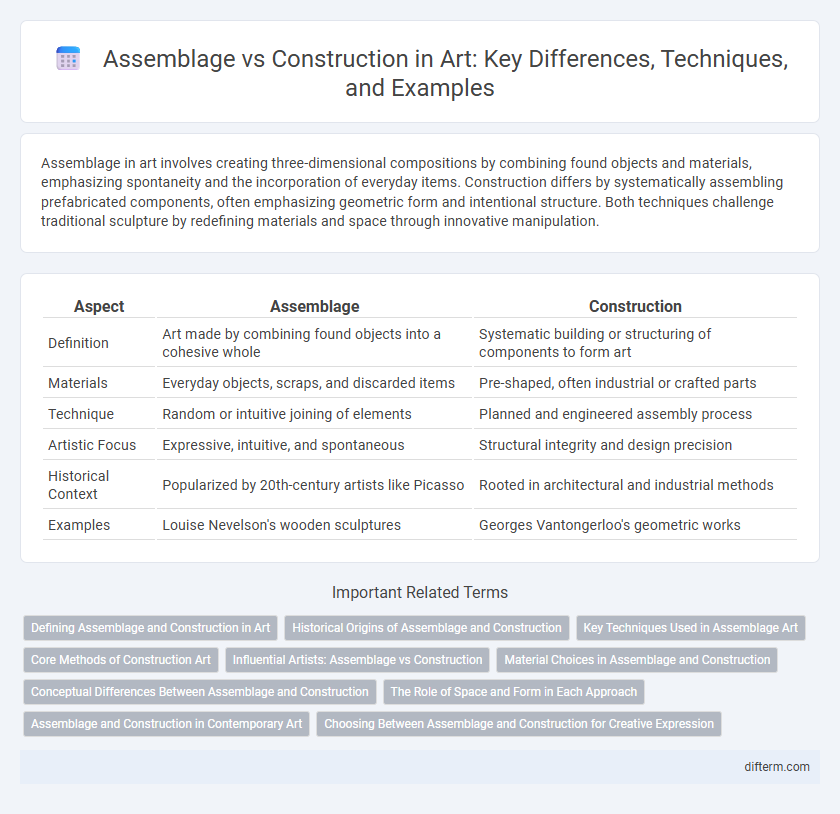Assemblage in art involves creating three-dimensional compositions by combining found objects and materials, emphasizing spontaneity and the incorporation of everyday items. Construction differs by systematically assembling prefabricated components, often emphasizing geometric form and intentional structure. Both techniques challenge traditional sculpture by redefining materials and space through innovative manipulation.
Table of Comparison
| Aspect | Assemblage | Construction |
|---|---|---|
| Definition | Art made by combining found objects into a cohesive whole | Systematic building or structuring of components to form art |
| Materials | Everyday objects, scraps, and discarded items | Pre-shaped, often industrial or crafted parts |
| Technique | Random or intuitive joining of elements | Planned and engineered assembly process |
| Artistic Focus | Expressive, intuitive, and spontaneous | Structural integrity and design precision |
| Historical Context | Popularized by 20th-century artists like Picasso | Rooted in architectural and industrial methods |
| Examples | Louise Nevelson's wooden sculptures | Georges Vantongerloo's geometric works |
Defining Assemblage and Construction in Art
Assemblage in art involves creating three-dimensional compositions by combining found objects and diverse materials, emphasizing the integration of pre-existing items into a cohesive whole. Construction refers to the methodical process of building artworks from raw materials, often emphasizing structural design and fabrication techniques. Both assemblage and construction highlight innovative approaches to form, texture, and spatial relationships within artistic practice.
Historical Origins of Assemblage and Construction
Assemblage art, emerging prominently in the early 20th century with artists like Pablo Picasso and Marcel Duchamp, involves creating three-dimensional compositions from found objects, often emphasizing spontaneity and visual juxtaposition. Construction, rooted in the Bauhaus movement and artists such as Naum Gabo and Vladimir Tatlin, focuses on engineered, industrial materials and precise assembly to explore spatial relationships and modern technology. The historical divergence highlights assemblage's embrace of everyday materials for expressive abstraction, contrasting with construction's emphasis on structural integrity and formal innovation.
Key Techniques Used in Assemblage Art
Assemblage art primarily utilizes found objects, mixed media, and three-dimensional compositions to create textured, layered works that emphasize depth and contrast. Key techniques include gluing, nailing, and welding disparate materials such as wood, metal, fabric, and paper to form cohesive, often abstract narratives. This approach contrasts with construction art, which relies more on architectural assembly and engineered structures, highlighting the tactile manipulation of everyday materials to evoke emotional and conceptual responses.
Core Methods of Construction Art
Construction art primarily involves assembling materials through methods like welding, bolting, or riveting to create three-dimensional forms, emphasizing industrial and architectural components. Unlike assemblage, which often uses found objects in a collage-like manner, construction art relies on deliberate fabrication techniques that highlight structural integrity and spatial relationships. This core method reflects the movement's alignment with modernism, focusing on precision, modularity, and the exploration of space through engineered forms.
Influential Artists: Assemblage vs Construction
Assemblage art prominently features artists like Joseph Cornell and Louise Nevelson, who created intricate compositions by assembling found objects and everyday materials into sculptural artworks. In contrast, construction art emphasizes the work of artists such as Pablo Picasso and Vladimir Tatlin, who used geometric forms and industrial materials to build structured, often abstract three-dimensional pieces. These influential artists shaped distinct methodologies, with assemblage focusing on repurposed elements and construction prioritizing deliberate fabrication and architectural principles.
Material Choices in Assemblage and Construction
Assemblage art employs found objects and diverse materials such as wood, metal, fabric, and everyday items to create layered, textured compositions that emphasize spontaneity and tactile contrast. In contrast, construction often involves deliberate use of industrial or uniform materials like steel, concrete, and glass to build structured, cohesive forms highlighting precision and architectural integrity. Material choices in assemblage foster eclectic and expressive narratives, while construction materials support stability and functional design.
Conceptual Differences Between Assemblage and Construction
Assemblage in art emphasizes the integration of found objects and pre-existing materials to create meaning through juxtaposition and recontextualization, highlighting the inherent narratives of each component. Construction involves the deliberate assembly of specifically crafted elements designed to achieve structural cohesion and formal unity, prioritizing the artist's intention and design process. The conceptual difference lies in assemblage's focus on transformation and symbolism of existing items, whereas construction centers on the purposeful fabrication of new forms.
The Role of Space and Form in Each Approach
Assemblage art emphasizes the intuitive combination of found objects, creating dynamic spatial relationships through juxtaposition and layering, which often produces a fragmented, multidimensional form. Construction art prioritizes the deliberate assembly of components, focusing on geometric arrangement and spatial coherence to achieve unified, often architectural forms. The role of space in assemblage is irregular and open-ended, while construction relies on controlled spatial organization to define form and volume.
Assemblage and Construction in Contemporary Art
Assemblage in contemporary art involves creating three-dimensional compositions by combining found objects and materials, emphasizing texture and narrative through juxtaposition. Construction focuses on assembling parts, often using industrial materials and techniques, highlighting structure and form as central elements of the artwork. Both methods redefine traditional sculpture by integrating everyday items, challenging the boundaries between art and objecthood.
Choosing Between Assemblage and Construction for Creative Expression
Assemblage involves combining found objects into a cohesive artwork, offering spontaneous and intuitive expression that highlights texture and materiality, while construction emphasizes building forms from raw materials through deliberate planning and technical skill. Artists often choose assemblage to convey layered narratives and evoke emotional resonance, whereas construction suits precise structural design and architectural exploration. Selecting between assemblage and construction depends on the desired balance of improvisation, conceptual depth, and formal complexity in creative expression.
assemblage vs construction Infographic

 difterm.com
difterm.com